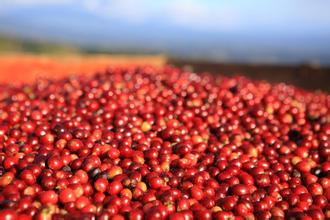Arabica Coffee Bean and Coffee Manor A brief introduction to Arabica Coffee Manor

Arabica coffee accounts for 70 -80% of all coffee production, and its excellent flavor and aroma make it the only coffee of all coffee species that can be drunk directly. However, its resistance to dryness, frost, diseases and insect pests is too low, especially the natural enemy of coffee-leaf rust, so all producing countries are committed to variety improvement.
Coffea arabica originated in Ethiopia's Abyssinia plateau (now known as the Ethiopian plateau), initially mainly as a medicine to eat (Islamic monks used as a treatment of physical and mental secret medicine or used to wake up), the 13th century to cultivate the habit of baking and drinking, the 16th century through the Arab region into Europe, and then become the world's favorite drink.
native species
It turned out that all the world's commercial coffee was Arabica coffee, but it was only in the late 19th century, when leaf rust caused the collapse of a large number of coffee plantations, that growers began to look for other disease-resistant varieties.
Arabica coffee is still the most important coffee variety, accounting for about 3/4 of the world's total coffee production. It is cultivated mainly in Latin American countries, but also in Indonesia and the Pacific islands. The geographical and climatic conditions of Brazil, the world's largest coffee producing area, are very suitable for the growth of Arabica coffee. The main coffee varieties planted are also Arabica coffee. Brazil's coffee production accounts for more than 1/3 of the world's total production.
The fruit of small coffee is smaller than medium coffee and large coffee. The berry is oval and generally has two seeds, which is called "coffee bean".
subspecies
The three earliest subspecies of the Coffea arabica series are varietal Blue Mountain, varietal Typica, and varietal Bourbon.
Jamaica Blue Mountain is an excellent coffee; tibeka coffee is native to Ethiopia and the southeast of Sudan and is the most widely cultivated coffee variety in the Western Hemisphere; Hawaii Kona and Blue Mountain coffee, which are higher in production, are comparable in quality and only 1 - 3 dollars in price.
Bourbon was introduced to the Americas by French immigrants from the Island of Bourbon (today's French Island of Reunion, located in the Indian Ocean east of Madagascar) in the 18th century, and is now widely cultivated in Brazil and other Western Hemisphere regions, and a small amount is also cultivated in Yunnan, China. The caffeine content of subspecies Bobang is 20% to 30% higher than that of subspecies Tepica, but less than that of most subspecies Coffea. The main branches initially grow upward at 45 degrees from the trunk and droop with fruit load. The lateral branches are dense, the fruit is many, the yield is high, but the berries are small and mature faster, so they are not resistant to strong wind and heavy rain. Popan coffee is the second best variety of Arabica coffee after iron pica. It has many fruits and higher yield, but the berries are smaller and mature slowly. Coffea arabica grown in Yunnan Province of China mainly consists of subspecies Tibika and subspecies Bobang. From the botanical point of view of coffee, Coffea arabica grown in Yunnan Province has genetic similarity with Jamaica Blue Mountain and Hawaii Kona, which are recognized as the best.
Important Notice :
前街咖啡 FrontStreet Coffee has moved to new addredd:
FrontStreet Coffee Address: 315,Donghua East Road,GuangZhou
Tel:020 38364473
- Prev

A brief introduction to the coffee plantation of washed coffee from Java, Indonesia.
Sumatra, the most legendary producing area, well-known coffee logos include Mandheling Mantenin, Lintong Lintong and Gayo Mountain Gayusan. Sulawesi Island, famous coffee includes Delaga Toraja. In addition, Bali, Flores and Timor are also important coffee producing areas where coffee from Java is traditionally washed. Sumatra and Su
- Next

Brief introduction of Manning Coffee Manor Rasuna Wahanna Manor
Manning coffee has a very strong flavor, fragrant, bitter, mellow, with a little sweetness. Most coffee lovers drink on their own, but it is also an indispensable variety for blending coffee. Because the Mantenin coffee bean itself does not have the sour characteristic, so the general special blending method is based on the Mantenin coffee bean, and it is not desirable when it is kept warm or iced coffee for a long time.
Related
- Does Rose Summer choose Blue, Green or Red? Detailed explanation of Rose Summer Coffee plots and Classification in Panamanian Jade Manor
- What is the difference between the origin, producing area, processing plant, cooperative and manor of coffee beans?
- How fine does the espresso powder fit? how to grind the espresso?
- Sca coffee roasting degree color card coffee roasting degree 8 roasting color values what do you mean?
- The practice of lattes: how to make lattes at home
- Introduction to Indonesian Fine Coffee beans-- Java Coffee producing area of Indonesian Arabica Coffee
- How much will the flavor of light and medium roasted rose summer be expressed? What baking level is rose summer suitable for?
- Introduction to the characteristics of washing, sun-drying or wet-planing coffee commonly used in Mantenin, Indonesia
- Price characteristics of Arabica Coffee Bean Starbucks introduction to Manning Coffee Bean Taste producing area Variety Manor
- What is the authentic Yega flavor? What are the flavor characteristics of the really excellent Yejasuffi coffee beans?

